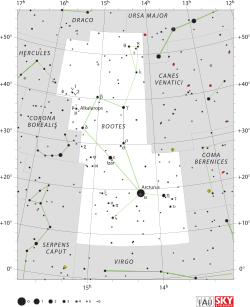Mu Boötis
| Observation data Epoch J2000 Equinox J2000 | ||
|---|---|---|
| Constellation | Boötes
| |
| A | ||
| Right ascension | 15h 24m 29.43147s[1] | |
| Declination | +37° 22′ 37.7613″[1] | |
| Apparent magnitude (V) | 4.31[2] | |
| B or Ba | ||
| Right ascension | 15h 24m 30.86726s[3] | |
| Declination | +37° 20′ 50.2761″[3] | |
| Apparent magnitude (V) | 6.98[4] | |
| C or Bb | ||
| Right ascension | 15h 24m 30.89704s[5] | |
| Declination | +37° 20′ 52.555″[5] | |
| Apparent magnitude (V) | 7.63[4] | |
| Characteristics | ||
| Mu1 Boötis | ||
| Spectral type | F2IV[6] | |
| U−B color index | +0.06[7] | |
| B−V color index | +0.31[7] | |
| R−I color index | 0.15 | |
| Mu2 Boötis | ||
| Spectral type | F9V + G0V[6] | |
| U−B color index | +0.13[7] | |
| B−V color index | +0.59[7] | |
| Absolute magnitude (MV) | 1.47[9] | |
| B or Ba | ||
Distance | 119.81 ± 0.07 ly (36.73 ± 0.02 pc) | |
| C or Bb | ||
Distance | 119.85 ± 0.08 ly (36.75 ± 0.02 pc) | |
Argument of periastron (ω)(secondary) | 43.5° | |
Argument of periastron (ω)(secondary) | 338° | |
| Details | ||
| Aa | ||
Rotational velocity (v sin i) | 89[6] km/s | |
| Ab | ||
Rotational velocity (v sin i) | 40[6] km/s | |
| B or Ba | ||
Gyr | ||
| C or Bb | ||
Gyr | ||
HR 5734, SAO 64687 | ||
| Database references | ||
| SIMBAD | μ1 Boo | |
| μ2 Boo | ||
Mu Boötis, Latinized from μ Boötis, consists of a pair of double stars in the northern constellation of Boötes, 120 light-years from the Sun.
Mu Boötis had the traditional name Alkalurops /ælkəˈljʊərɒps/, although the International Astronomical Union now regards that name as only applying to μ1 Boötis.[11]
System

The primary pair, component A, is designated μ1 Boötis and the two components an
]The secondary, consisting of components BC, is designated μ2 Boötis and they have a separation of 2.2″. The two double star systems are separated by 107″, with matching parallaxes and
Nomenclature
μ Boötis (Latinised to Mu Boötis) is the star's Bayer designation. It also bears the Flamsteed designation 51 Boötis.
The system's traditional name Alkalurops is from the Greek καλαύροψ kalaurops "a herdsman's crook or staff", with the Arabic prefix attached.[12] It has also been known as Inkalunis (from the Alfonsine tables), Clava (Latin 'the club') and Venabulum (Latin 'a hunting spear').[13] In 2016, the International Astronomical Union organized a Working Group on Star Names (WGSN)[14] to catalogue and standardize proper names for stars. The WGSN approved the name Alkalurops for μ¹ Boötis on 21 August 2016 and it is now so entered in the IAU Catalog of Star Names.[11]
It is known as 七公六, Qī Gōng liù (the Sixth Star of the Seven Excellencies) in Chinese.[15]
Properties

μ1 Boötis is a yellow-white F-type subgiant with an apparent magnitude of +4.31.
Separated from its brighter companion by 108
References
- ^ S2CID 244398875. Gaia DR3 record for this source at VizieR.
- ^ Bibcode:1990A&AS...85.1015M.
- ^ S2CID 244398875. Gaia DR3 record for this source at VizieR.
- ^ S2CID 119047709.
- ^ S2CID 244398875. Gaia DR3 record for this source at VizieR.
- ^ S2CID 122667185.
- ^ Bibcode:1966CoLPL...4...99J.
- S2CID 119231169.
- S2CID 119257644.
- S2CID 55586789.
- ^ a b Mamajek, Eric; et al. (June 30, 2017), IAU Catalog of Star Names, IAU Division C Working Group on Star Names, retrieved 28 July 2016.
- )
- )
- ^ IAU Working Group on Star Names (WGSN), International Astronomical Union, retrieved 22 May 2016.
- ^ (in Chinese) AEEA (Activities of Exhibition and Education in Astronomy) 天文教育資訊網 2006 年 6 月 26 日 Archived 2011-05-22 at the Wayback Machine

